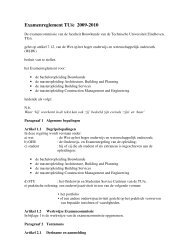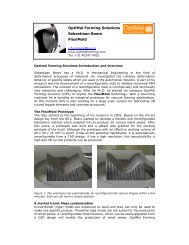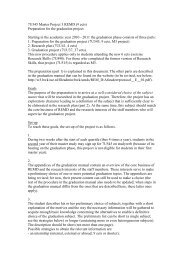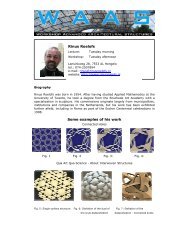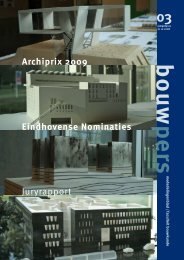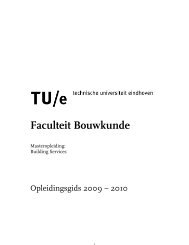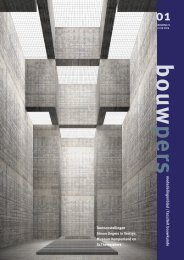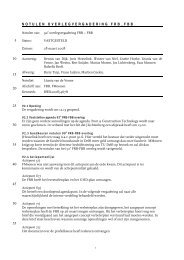afst.bundel 8 MEI 07 - Technische Universiteit Eindhoven
afst.bundel 8 MEI 07 - Technische Universiteit Eindhoven
afst.bundel 8 MEI 07 - Technische Universiteit Eindhoven
Create successful ePaper yourself
Turn your PDF publications into a flip-book with our unique Google optimized e-Paper software.
<strong>afst</strong>udeer<strong>bundel</strong> faculteit bouwkunde<br />
Afbeelding 1 Working principle of an earth-to-air heat exchanger<br />
9<br />
When all the soil parameters would be tackled simultaneously<br />
this would result in a maximum increase of 120%.<br />
The optimum design of an earth-to-air heat exchanger is an<br />
exchanger that consists of short pipes, small diameters and low<br />
airspeed. But when designing it is essential to keep the air flow<br />
turbulent and pressure loss low.<br />
The effect of the material of the exchanger on the energy<br />
savings is minimal compared to the other design criteria.<br />
It is better to select the material based upon practical design<br />
considerations like groundwater level. The largest savings are<br />
obtained in the first two meters in depth. After three meters the<br />
savings are minimal while the costs of digging increase significantly.<br />
The case study for the townhouse showed an average coverage<br />
between 6% and 8% of the annual heating load. The system<br />
performers more efficiently in cooling mode resulting in<br />
average coverage between 78% and 90%. The system is proofed<br />
to be effective for houses regarding CO2 reduction. Nevertheless<br />
the nowadays costs for such a system result in long pay back<br />
times. Possibly the initial costs will be reduced when applying<br />
these systems on large scale systems. The obtained CO2<br />
reduction is 5-6% and the calculated payback time is 17-24 years<br />
excl. filter (44-81 years inclusive filter replacement).<br />
On a large scale project as a shopping mall the performance is<br />
better but the initial costs increase rapidly due to the need for<br />
special products. Therefore payback times between 88 and 338<br />
years are found when including the replacement of the extra<br />
filters. Looking at the energy coverage (55% of the heating and<br />
21 % of the cooling loads are covered) and the CO2 reduction<br />
(218,8 ton) the system makes sense after all. In order to make<br />
this system more cost effectively there should be searched for<br />
cheaper pipe materials.<br />
Based on the payback time, the coverage of the heating/cooling<br />
demand and environmental savings the choice of applying this<br />
technology is not based on the financial reasons but more on<br />
ideological and environmental reasons.



